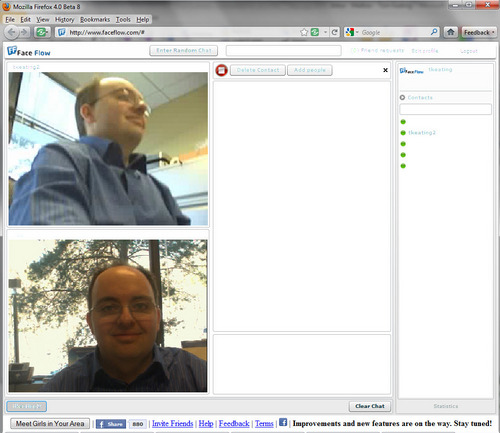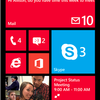First, some background... Back in August 2010 I wrote how the latest version of Adobe Flash Player 10.1 adds support for RTMFP Groups. This is huge because it enables clients to easily communicate with other clients in a network in order to share the transport of media and communications without maintaining a connection to every peer in the group. Groups can be defined by their functionality and access can be controlled by the client application, whether it's a VoIP app, chat app or a social networking app.
They also added support for Directed Routing, which enables a developer to create communication applications and send data messages to a specific peer in the group. Critical features of RTMFP include low latency (critical for VoIP), end-to-end peering capability, security and scalability.
In the past, in order to scale you have to add additional Flash Media Servers, but with RTMFP Groups you can instead have application-level multicast for increased scalability. As seen in the graphic below, with Flash 10.1, you can have a very scalable 1-to-many (mesh architecture) leveraging the RTMP protocol, Status 2.0, and P2P communication.

Well, this new Adobe P2P voice/video technology is exactly what FaceFlow is leveraging. It greatly reduces the need for centralized servers (or supernodes like Skype) as well as the bandwidth requirements. I took FaceFlow for a spin. It was easy to sign-up and register. Once registered I registered a second account on another PC to make my first video call. I 'friended' my second account and after accepting the friend invite I made a video call from my first account to the second account all on the same LAN segment. The video frame rate is excellent, however, it seems they compromised a bit on video quality. The video had artifacts in it at times, especially when moving. But overall, the video was pretty decent. Here's a screenshot. Click for larger size:

Next, I tried out the random chat feature, a Chatroulette clone. Of the 7 random chats I tried, 2 were male porn-related following in Chatroulette's steps. I decided to move on and test the other features. Currently, you can only search on name or username, so FaceFlow needs to have better profile searching. Of course, they only ask for your name, username, and birthday, so they'd also have to ask for City and State if they want to provide more useful searching for dating applications or if trying to find a friend or classmate in the local area. It does have the ability to attach a picture to your profile which you can easily change.
You can be notified via email when you get a friend invite. I think they should add a 'report' feature. I got 3 friend invites from people I don't know in 3 days. Granted I get friend requests on Facebook too, but that's a much larger user pool that might be "spammy" and I just joined FaceFlow, so no one even knows I'm on it.
I spoke with the Dany Pelletier, Founder of FaceFlow about their offering.
First, I asked him if they support more than 3 video participants. Dany said, "So far, we are only accepting 3-way video calls. If everybody around the world had good bandwidth, we'd easily be able to add additional webcams, but that's not the case right now."
When asked about the video quality he responded, "We are currently working on a system that will adjust users' bandwidth (video quality) according to their internet speed, by reducing or increasing it optimally in a way to stay at a given FPS rate. With that said, people with high bandwidth will have a high quality video with good FPS, and people with lower bandwidth will have a lower quality video with good FPS. You would need very low bandwidth to have a very bad video quality anyway."
He then commented on how I said my two-way video had some artifacts. "About the actual quality, we've just increased the quality for 2-way video chat, but the same quality that you've seen when testing the website has been kept for the 3-way video chat - still a decent quality however - until we have the FPS/bandwidth management system in place."
I asked about monetization and he stated, "We have a lot of plans for FaceFlow. For example, one eventual project would be to add VoIP for landline calling, at very competitive rates, so people can use FaceFlow for their communication needs on any computer, anywhere without having to download anything." He continued, "I don't intend to make any features besides landline calling a paid feature. I want as many people as possible to use the service, and we might be adding ads eventually, such as in-video ads similar to the Google ads you can see in YouTube videos. We have no monetization plans confirmed yet, but the service will be free to use for sure (except an eventual landline calling feature.)"
Next, I asked about their architecture. He responded, "Our backend right now is entirely peer-to-peer, there is no client-server-client communication at all. We are also working on new communication features such as broadcasting and chat rooms, which will be using the newest features in Flash 10.1, such as multi peer-to-peer. These flash 10.1 features will also be useful for an effective scalability of the video conferencing system."
Tom: Ah, so it is P2P. Guess that makes infrastructure easier for you – less bandwidth requirements.. You just have to do the handshaking / call setup and then all the peers communicate together. Can you confirm my assumption?
Dany: In fact, there are a lot less bandwidth requirements when using p2p, which makes an effective scalability easier, and allows me to offer the service for free even when features such as 6-way video chat will be available. You are right, the server has to do the handshake to connect the users together, and then p2p takes place. Flash 10.1 will be required when in a video conference with many people, for example when more than 4 webcams. The bandwidth management between the peers is very effective, and this is what we will be leveraging.
Tom: You offer some Chatroulette type functionality. I hit 2 porn out of maybe 7 tries. Happens of course. But just curious your thoughts on if modeling chatroulette will help give you more users due to ‘porn’ fans. And on a related note, do you see traction yet with your small userbase (15,000) of random people doing non-porn stuff. Any guesstimate on the percentage?
Dany: About the random chat system, I wanted a way for people to be able to meet new people, and stay in touch directly on the website. For example, Chatroulette and many other video chat websites don't have features such as a contact list, and people would use for example Skype to stay in touch. On the other way, people on Skype would use Chatroulette to meet new people. The porn in the random chat is not what attract users on FaceFlow, and we've taken steps in order to reduce it at a minimum. For example, we've recently developed a moderator system where we will be able to ban inappropriate behavior for several days. From now on we will be more aggressive and moderate the random chat 24 hours a day, so that people can meet new people in a system of trust.
Most of the people come on the website with good intention, because about 70% of the users so far use the video calling and conferencing feature more than the random chat.
Tom: Care to share something about the core roots of the company. i.e. the founder(s), where you went to college, why you decided to create this product, etc.
Dany: I am a 21 years old student in business administration in Québec, Canada. Similar to some points above, when I saw the new Adobe Flash technologies appear (about a year ago), I wanted to have a website similar to Skype, and include other communication features such as chat rooms so people could meet other people directly on the website. When I saw Chatroulette, I thought it would also be a good feature to add.
I've already expressed my displeasure over Skype now charging for group calling, so FaceFlow might be a good solution for you to check out. Currently, it maxes out to 3 participants, but as previously stated, they're working on supporting more.
Lastly, here's their video promo:













